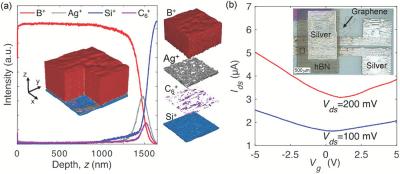
by MBF Admin | Nov 9, 2020 | 2D materials, Aerospace, AGM, Angstron Materials, Audio, Boron Nitride, Development, Electronics, GNPs, Graphene 3D Printing, Graphene applications, Graphene Ink, Graphene Solar, Investment, Products, Research, Technical / Research, Transistors
Researchers from the University of Nottingham’s Centre for Additive Manufacturing (CfAM) have reported a breakthrough in the study of 3D printing electronic devices with graphene.Characterization of the fully inkjet‐printed graphene/hBN FET. Photo from articleThe...
by MBF Admin | Oct 31, 2020 | 2D materials, Aerospace, AGM, Angstron Materials, Audio, Development, Graphene coating, Investment, Products, Research, Technical / Research
Researchers at Los Alamos National Laboratory have found a possible way to evaluate the effectiveness of graphene-based protective barriers. “It’s about creating and using extra-corrosive air and observing its accelerated effect on the graphene-protected materials....

by MBF Admin | Oct 31, 2020 | 2D materials, Aerospace, AGM, Angstron Materials, Audio, Development, Graphene applications, Graphene production, Investment, Products, Research, Rice University, Technical / Research
Rice University’s process to produce pristine graphene in bulk from waste (dubbed “flash graphene”) was recently modified for recycling plastic. Instead of raising the temperature of a carbon source with direct current, as in the original process, the lab first...
by MBF Admin | Oct 29, 2020 | 2D materials, Aerospace, AGM, Angstron Materials, Audio, Development, Graphene applications, Graphene batteries, Graphene Ink, Graphene Oxide, Investment, Products, Research, Technical / Research
Australian Advanced Materials has announced it is developing a graphene-oxide-based ink battery that is able to self-charge within minutes.The cells will be created with a printable ink and designed to generate electricity from humidity in the air or skin surface to...
by MBF Admin | Oct 28, 2020 | 2D materials, Aerospace, AGM, Angstron Materials, Audio, Development, Graphene applications, Graphene Flagship, Graphene Sensors, Investment, Photonics, Products, Research, Technical / Research
An international team of researchers recently reported its success in creating a new type of graphene-based photodetector. The team integrated three concepts to achieve the new device: metallic plasmonic antennas, ultra sub-wavelength waveguiding of light and graphene...
by MBF Admin | Oct 21, 2020 | 2D materials, Aerospace, AGM, Angstron Materials, Audio, Development, Graphene applications, Investment, Photonics, Products, Research, Technical / Research
Researchers at University of California Berkeley, Washington University in St. Louis and Lawrence Berkeley National Laboratory have stacked two sheets of graphene on top of each other and twisted them, which resulted in the conversion of a common linear material into...



